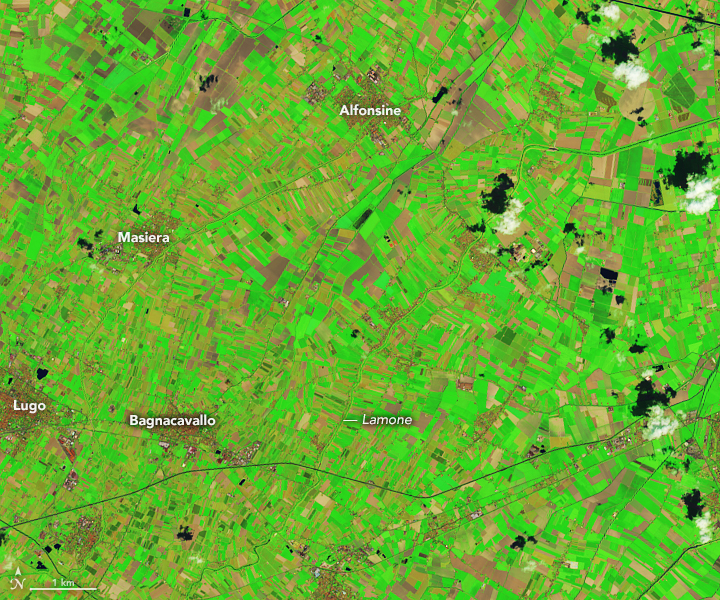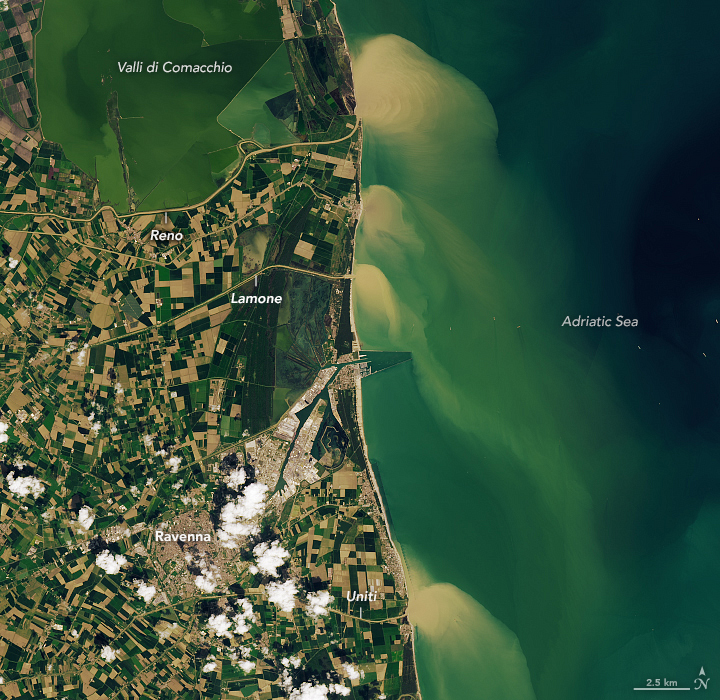
A Deluge in Italy
Downloads
- italyflooding653_oli2_2023116_lrg.jpg (1214x1190, JPEG)
- italyflooding653_oli_2023124_lrg.jpg (1214x1190, JPEG)
- italysediment_oli_2023124_lrg.jpg (3833x3604, JPEG)
Metadata
- Sensor(s):
- Landsat 9 - OLI-2
- Landsat 8 - OLI
- Data Date: April 26, 2023 - May 4, 2023
- Visualization Date: May 10, 2023
Parts of northern Italy have been impacted by severe flooding and landslides after heavy rainfall pummeled the Emilia-Romagna region on May 2–3, 2023. Rainfall amounts exceeded 20 centimeters (8 inches) in a 24-hour period in some locations. The floods disrupted rail services, forced hundreds of evacuations and rescues, and caused at least two deaths, according to news reports.
The image above (right), acquired by the Operational Land Imager (OLI) on the Landsat 8 satellite, shows flooding adjacent to the Lamone river on May 4, 2023. The image on the left, acquired by OLI-2 on Landsat 9, shows the same area on April 26, 2023, before the rains. These images are false-color, such that water appears dark blue, vegetation is green, and bare ground is brown.
As many as 13 rivers reached the highest alert level, with the Lamone river in the province of Ravenna seeing a particularly sharp rise. One sensor recorded its levels increasing from 1 meter (3.3 feet) to 11 meters (36 feet) in 24 hours, and one of its embankments near the town of Faenza failed.
Paolo Billi, a professor at the University of Ferrara, has studied Italian river hydrology and sediment transport. Acknowledging that these floods were destructive, Billi noted this type of event is not unusual in Emilia-Romagna or across the broader Italian landscape.
“The frequency of flash floods has increased throughout the last two decades,” Billi said, adding that the recent event fits the mold of such floods. These events are characterized by high-intensity rainfall over the course of several hours, sometimes affecting a very localized area. The 24-hour rainfall amount can equal 25 to 50 percent of annual precipitation, according to Billi. “In many cases, the negative effects of intense rainfall are exacerbated by urbanization and river channel narrowing that take land away from the river corridor,” he said.
The heavy rains also tend to cause rapid soil erosion and flush large amounts of sediment out to sea. The OLI on Landsat 8 captured this image (above) of sediment-laden waters flowing from multiple rivers into the Adriatic Sea on May 4, 2023.
The Emilia-Romagna region has been undergoing severe drought. Last summer brought low rainfall, higher-than-average temperatures, and critical water shortages. The level of the nearby Po River, which dropped to concerning levels in the summer of 2022, swelled by 1.5 meters (5 feet) in this rain event. However, for the second year in a row, the amount of water available from snowpack in the Po basin is well below average.
References & Resources
- Billi, P. and Fazzini, M. (2017) Global change and river flow in Italy. Global and Planetary Change, 155, 234–246.
- CIMA Research Foundation (2023, May 5) Alluvione in Emilia-Romagna: l’anomalia combinata di cielo e terra. Accessed May 10, 2023.
- CIMA Research Foundation (2023, April 13) Aprile, il deficit di neve si stabilizza a -64%. Accessed May 10, 2023.
- CRISIS24 (2023, May 3) Italy: Disruptions due to flooding ongoing in parts of Emilia-Romagna Region as of May 3. Accessed May 10, 2023.
- Emilia-Romagna Energy Environment Prevention Agency (2022, September 30) Siccità 2022 in Emilia-Romagna. Accessed May 10, 2023.
- FloodList (2023, May 4) Italy – 2 Dead, Hundreds Displaced After “Unprecedented” Floods in Emilia-Romagna. Accessed May 10, 2023.
- Reuters (2023, May 3) Torrential rain lashes northern Italy, killing at least two people. Accessed May 10, 2023.
NASA Earth Observatory images by Lauren Dauphin, using Landsat data from the U.S. Geological Survey. Story by Lindsey Doermann.
This image record originally appeared on the Earth Observatory. Click here to view the full, original record.
